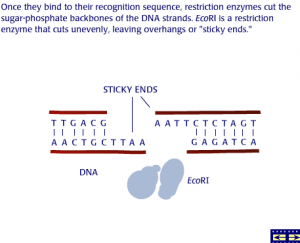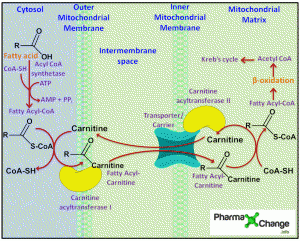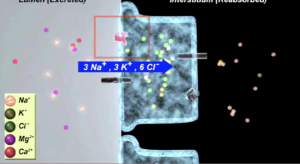Liposomes are a novel drug delivery system which allow the encapsulation or incorporation of drugs into nanoparticle size vesicles for their delivery. This animation covers the basic concepts of liposome structure, and use.
Liposomes are made of phospholipids (hydrophobic tails with hydrophilic head groups) which arrange themselves into lamellar sheets of bilayers to minimize contacts with the aqueous environment. These sheets then roll together to form spherical vessicles in order to prevent contact with water further via the edges. Hydrophilic drugs are encorporated in the central hydrophilic portion of the vesicle, while the hydrophobic drugs can be incorporated in the bilayer membrane of the liposome.
We also recommend watching the Animation of Liposome Basics – Part 2 which covers the preparation and sizing of liposomes.
This animation is provided by Encapsula Nanosciences and has been posted on YouTube by nanoliposomes.
Find Books on Liposomes
Check out some really useful books on liposomes
Transcript:
” The basic molecular building block of a cell membrane as well as a typical liposomal membrane is a phospholipid. Phospholipids are built on a glycerol backbone. Phosphorylated molecules are esterified to carbon 3 of the glycerol forming a polar head group. Fatty acids are esterified to carbon 1 and 2 of the glycerol. Phospholipids are known as polar lipids because the phosphorylated portion is polar, or water soluble; while the fatty acid tails of the phospholipids are non-polar or fat soluble.
Fatty acids are referred to saturated when the carbons in the chain are covalently bonded to each other by a single bond and each carbon in the chain has a maximum number of hydrogen atoms covalently bonded to it. In other words, the carbon chain is saturated with hydrogen atoms. The chain length can vary from 3-24 carbons. Unsaturated fatty acids, contain atleast one double bond in the carbon chain. Each double bond causes a kink in the carbon chain of unsaturated fatty acids. The most natural phospholipids contain palmitic and oleic acids. However, synthetic phospholipids can be synthesized with any combination of fatty acids.
The most common phospholipid head group found in nature is phosphoryl choline or PC. Other head groups include phosphoryl ethanolamine or PE, phosphoryl glycerol known as PG, phosphoryl inositol known as PI, and phosphoryl serine known as PS. The PC and PE head groups have no charge, while the PG, PI and PS head groups are negatively charged. The most common naturally occuring phospholipid is POPC.
Phospholipids are often drawn as a ball representing the head group, with two tails attached representing the fatty acids. In an aqueous environment phospholipids orient themselves into a thermodynamically stable structure called a bilayer. This flat sheet of lipid then curves into a geometric structure which has no edges – a sphere. Small Unilamellar Vessicles or SUVs range from 30-70nm in diameter. While Multilamellar Vesicles or MLVs can be several microns in diameter. LUVs or large unilamellar vessicles range from 70-120nm in diameter.
Uses of Liposomes:
Liposomes can encapsulate both water soluble and fat soluble drugs which is slowly released as the liposome is broken down by enzymes and acids found in tissues and cells especially at disease sites. Many fat soluble compounds including drugs can be incorporated into the phospholipid bilayer. For injection into animals, liposomes with cholesterol in their membranes are more physically stable in the blood stream. Incorporating tocopherols in the membrane can increase the chemical stability of unsaturated phospholipids.
Liposomes can have various molecules attached to their surface. The most common surface modification is pegylation, in which the polymer polyethylene glycol is covalently linked to the surface of the liposome. Small pegylated liposomes circulate in the blood stream longer than plain liposomes. Antibodies can be attached to liposomes for targetting purposes. Many studies show that the targeting is more effective if the antibody is attached to a spacer arm rather than directly to the liposome surface.
Fluorescent liposomes can be made by encapsulating fluorescent molecules in the aqueous interior of the liposome or by adding fluorescent lipids to the bilayer. In some cases it is useful to have both the aqueous content and the lipid bilayer labelled simultaneously with different fluorophores.
Liposomes are important tools for characterizing membrane associated proteins in their native environment. Liposomes can be used to mimic cell membranes when studying the interactions of drugs and other molecules with cells.
Liposomes can encapsulate DNA or RNA in their aqueous space for delivery to cells. Another type of liposome containing positively charged lipids such as DOTAP bind the negatively charged nucleic acids to its surface through electrostatic interactions. These so called lipoplexes can be used to deliver nucleic acids to cells. Some types of lipoplexes sandwich the nucleic acids between the bilayers. However, many studies show that these are less effective delivery vehicles than other types of lipoplexes which encase the nucleic acids inside hexagonaly packed lipid tubes. Both liposomes and lipoplexes have been shown to deliver nucleic acids to cells invitro and invivo.”




Hello to all, how is all, I think every one is getting more from this web site, and your views are pleasant designed for new
viewers.
Hey. This animation of liposomes is really great. I love this website. It has great content. Keep up the good work. This has really helped me study various topics in pharmacy much better.